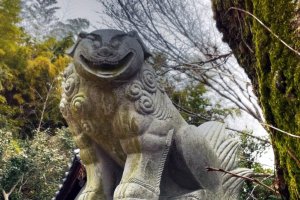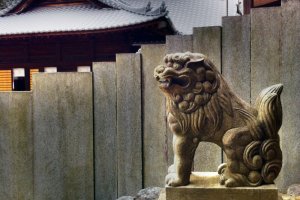The area around Kume Station on the Iyotetsu Yokogawa Line from Matsuyama has a number of attractions within a short walking distance of each other. One is Jodo-ji Temple, the 49th of the 88 sacred temples of Shikoku. Another is the Sora to Mori onsen and relaxation facility. And between these two is the Hio-Hachiman Shrine with it’s intriguing and enticing entrance gate standing on a busy road junction. When I visited Hio-Hachiman Shrine, my purpose was have an onsen at Sora to Mori, but spotting a road up the hill to the shrine behind the onsen car park, I found myself drawn up the hill. For me, there’s something irresistible about a shrine hidden among the trees on a forested hilltop.
One of the obvious characteristics of Hio-Hachiman Shrine is its profusion of stone lions or shishi, which always come in pairs and stand on either side of the entrance to a shrine. Like all of the guardian deities at shrines and temples, one has its mouth open saying “Ah” and the other has its mouth closed saying “Um”, which combined makes the sound “Aum”, supposedly the sacred sound heard at the birth of the universe.
At Hio-Hachiman, there are lions all over the place, and each is carved in a very different style. The main guardian lions are in a style unlike any I’ve seen elsewhere, with cheerful grins. They’re modern replacements for old but similar lions who have been placed side by side nearby. They have a distinctly conspiratorial air about them as if they’re whispering to each other.
Another feature of this shrine is the strings tied in rows between trees, tied with white fortune-telling papers. Visitors can pay a small fee to draw a lot and receive one of these papers which provide a vague augury of good or ill fortune. Whichever it is, the slip is meant to be left at the shrine, in the hope of realizing the good fortune or avoiding the bad.
Behind the shrine and to the right, a path leads further up the hill to a viewing platform that offers a panoramic view of the southern part of Matsuyama to the Seto Inland Sea and some rugged mountains.































